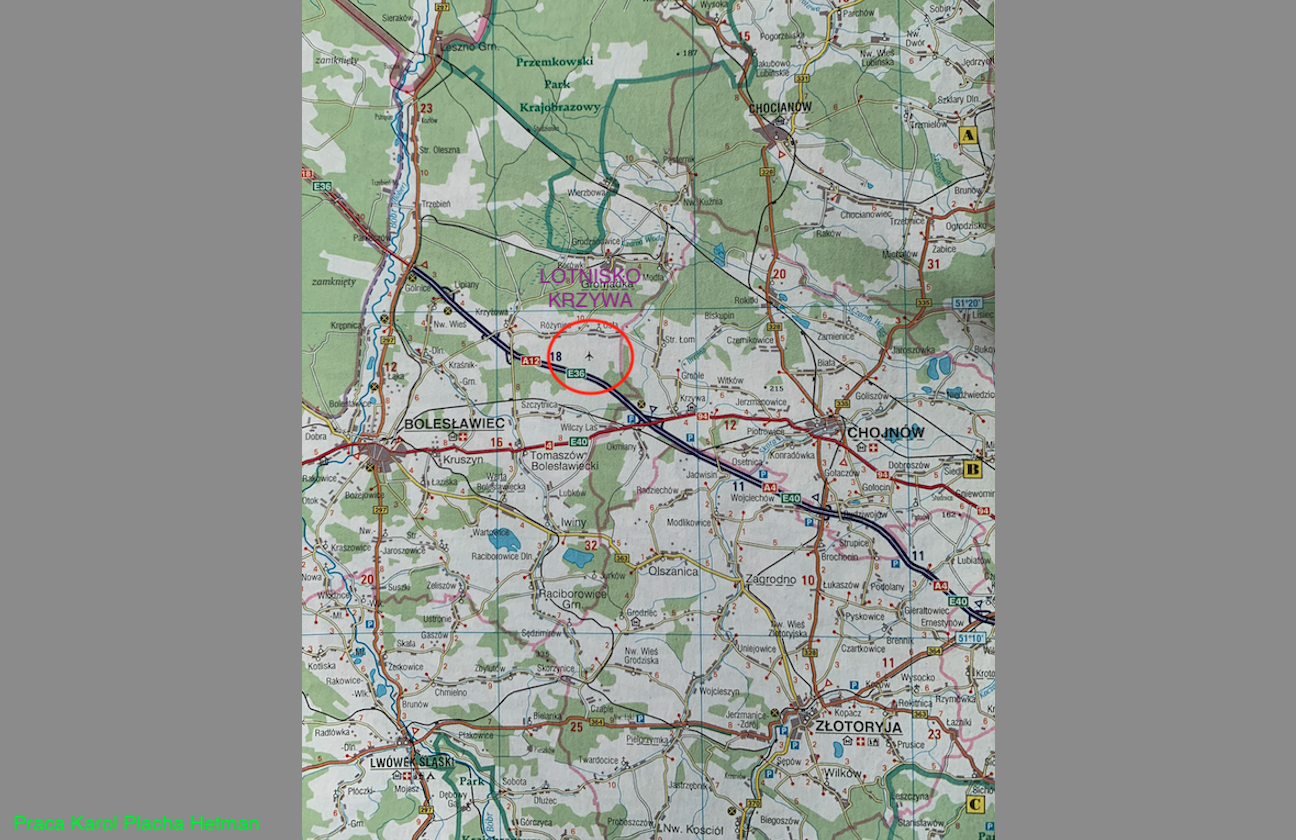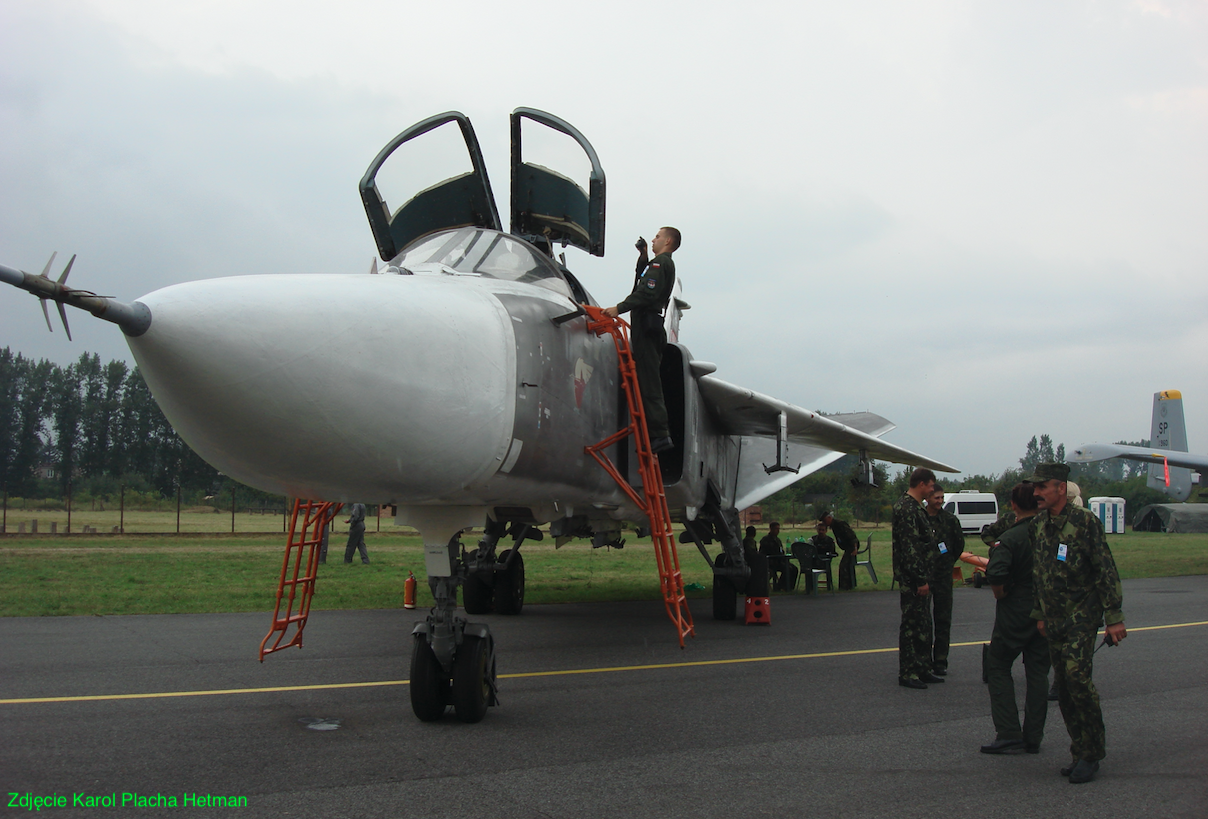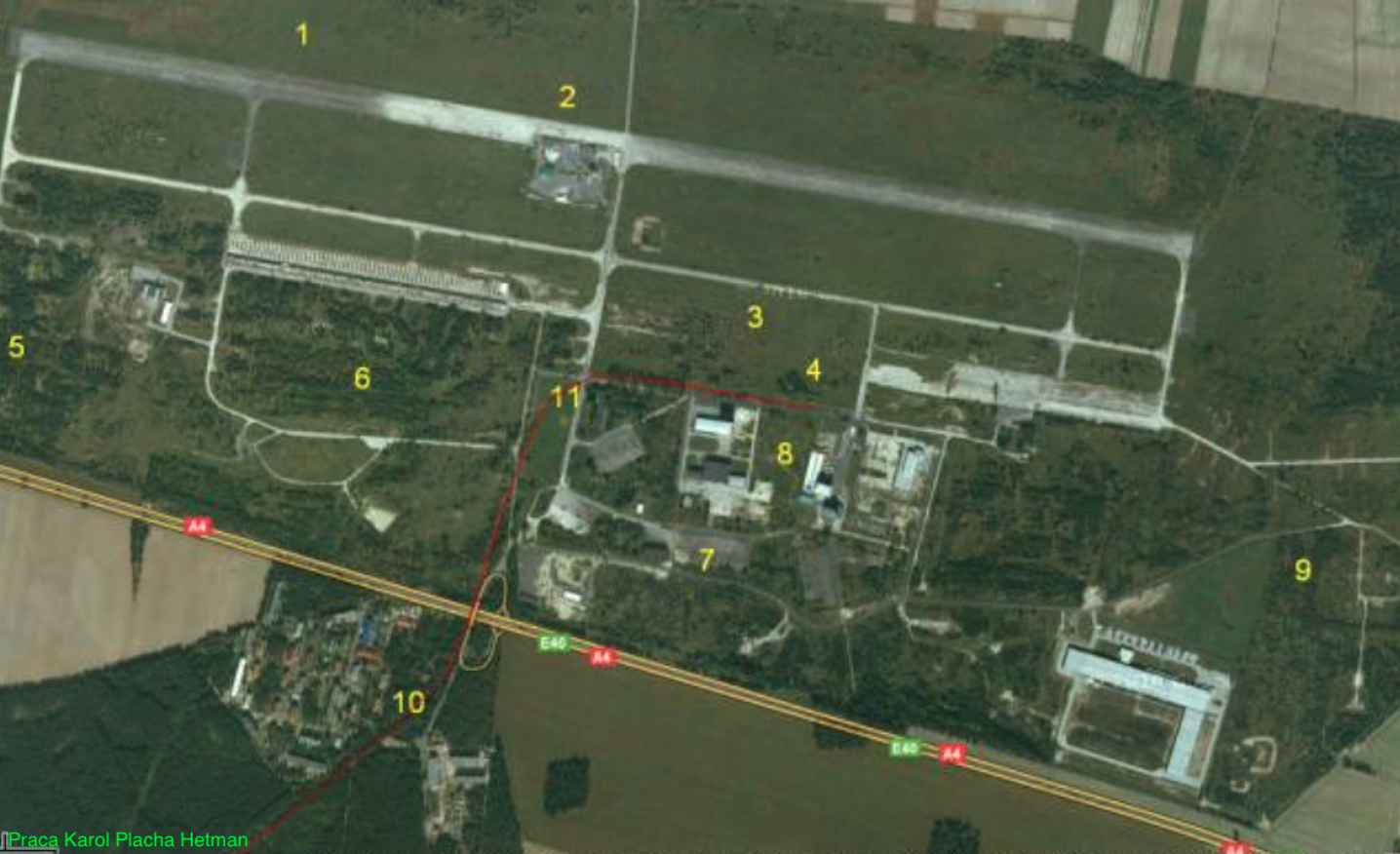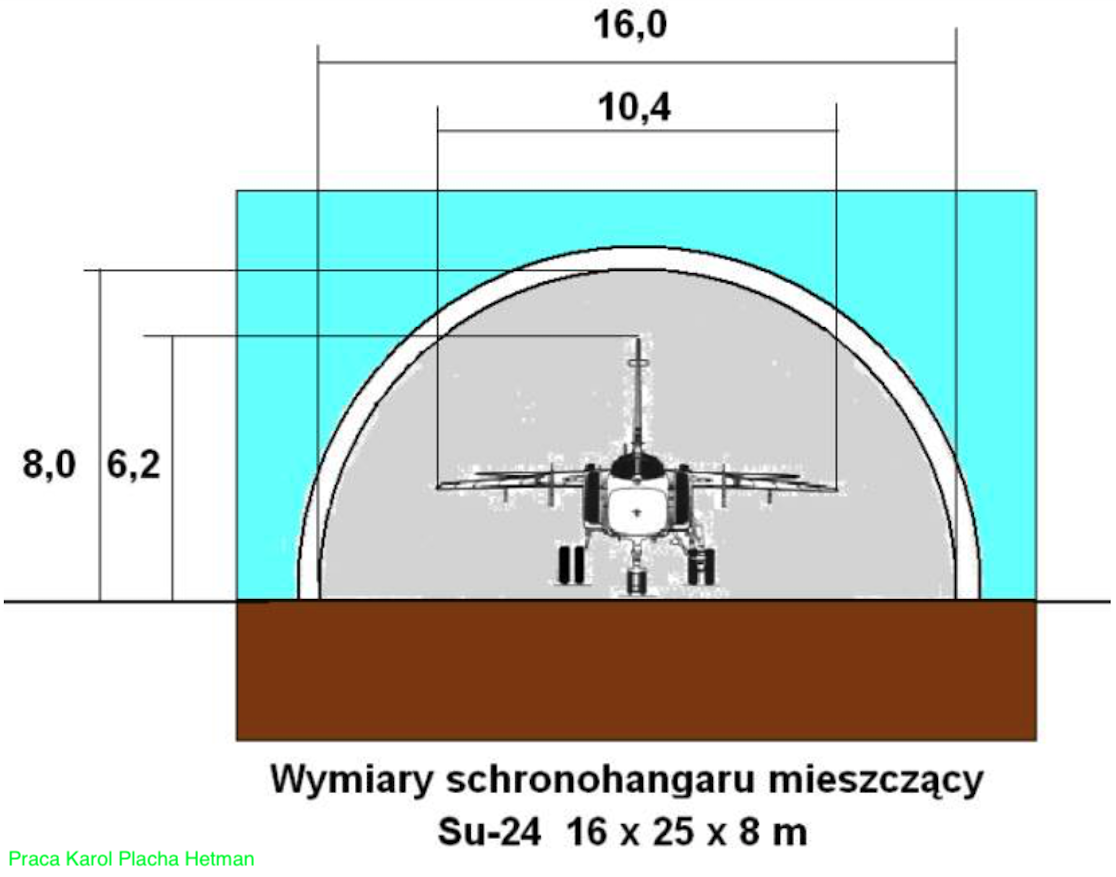Legnica 2011-09-28
Former Soviet airport in Krzywa near Legnica.
Geographic coordinates: 51.311 N 15.729 E. Elevation 207 m.
Krzywa airport.
Krzywa Airport has become a thing of the past and no plane will take off from it anymore. Krzywa Airport is another airport in Poland operated for nearly 50 years by the troops of the Moscow state. It was one of the most important Soviet airports in Poland, next to the airports in Brzeg, Chojna, Bagicz, Kluczewo, Szprotawa and others. The airport in Krzywa was located in the Lower Silesian Voivodeship, near the town of Bolesławiec, between the towns of Różniec and Szczytnica, on the A 4 highway. The facility operated by the Soviets is located on the border of the Warta Bolesłwiecka Commune and the Gromadka Commune. There is a residential estate in the Warta Bolesławiecka commune. It was assigned to the town of Szczytnica. There is an airport in the Gromadka commune. All because the border is the A 4 motorway.
History of Krzywa Airport.
It is very difficult to determine in what year Krzywa Airport was built. Its construction probably began when the highway from Dresden to Wrocław was practically completed. The location of the airport was determined by the route of the highway. A railway siding to the airport was built already during World War II. In September 1939, Germanic bombers took off from Krzywa Airport to attack Polish cities.
It should be written about the Krzywa airport that on October 1, 1938, the German Air Force bought land to establish an airport. The airport became part of the Legnica airport hub. In addition to the airport itself, workshops were built to assemble and repair combat aircraft. After the outbreak of the war, in the forests near Szczytnica, the Germans established a prisoner of war camp. The prisoners worked not only on the expansion of the airport, but also on the assembly of combat aircraft. These included Focke-Wulf Fw 190 fighters. Today, it is not known where exactly the POW camp was. It is known that when going to the airport, the prisoners had to pass through a tunnel under the Wrocław-Dresden/Berlin highway. Satellite photos of the forests south of the highway show places covered with other trees.
On February 15, 1945, Krzywa Airport was occupied by Soviet troops. Theoretically, the airport was awarded to the Polish Army. But this is only a theory and Polish planes have never been stationed here. According to available information, in 1953, the facility was officially taken over by Soviet soldiers. Presumably, it was the result of an agreement between PGW AR and the command of the Polish Army, which was a fiction at that time anyway, because the highest commanders in the Polish Army were citizens of the Moscow state. On the basis of this agreement, among others, Poland was granted Malbork Airport and Siemirowice Airport, and Krzywa Airport was built.
Krzywa airfield had an excellent location for Soviet combat aviation. It was close to large training ground complexes and near state borders, and in a short distance there is the city of Legnica, with the PGW AR command.
In 1953, Muscovites began to expand the Krzywa Airport. This was necessary because the planes being developed at that time required increasingly longer RWYs. The airport’s facilities have been greatly expanded. More hangars were built. Krzywa Airport became a strong Soviet base in Poland.
The airport area is similar in shape to a rectangle. Approximately 3,400 m long and 1,400 m wide. The total area, including the housing estate, is 476 hectares. The infrastructure was very rich, as we wrote below.
Name of Krzywa Airport.
Why was the airport named Krzywa? Krzywa is located approximately 8 km east of the airport. However, closer are towns such as Różyniec, Osłan and even Szczytnica. The crux of the matter, however, was the road leading from Legnica to the Airport. Soviet soldiers coming from Legnica took the road that is now No. 94, through Chojnów, and the last town before the airport was the town of Krzywa. That’s why the airport was named so. In the literature we can also find information that Legnica had two airports. Krzywa Airport was the second airport.
Soviet units in Krzywa.
Until 1992, the 3rd Bomber Aviation Regiment was stationed here. It was under the command of the 149th Bomber Aviation Division from Szprotawa Airport. The 3rd Fighter Aviation Regiment, together with the entire Division, was transferred to Poland on May 1, 1955, from China. Interestingly, the planes remained in China. Only the staff were transported by rail. The entire staff of the Division was sent to Szprotawa Airport. The 3rd PLM was initially equipped with MiG-17 fighter and UTMiG-15 (MiG-15 UTI) training aircraft. On September 1, 1960, the regiment became a fighter-bomber unit (3. PLM-B) and began to be rearmed with Su-7 B fighter-bomber planes. These were planes capable of carrying nuclear bombs (atomic bombs, as they were then called). Certainly, in 1960, construction of a bomb depot for nuclear (atomic) bombs began at Krzywa Airport. In 1961, the 3rd PLM-B was transferred to Krzywa Airport. At that time, the regiment had Su-7 B, Su-7 BM, Su-7 U aircraft. These aircraft were operated until 1976, when the regiment began to be equipped with MiG-27 aircraft. MiG-23 UB was used as a training and combat aircraft. MiG-27 aircraft were operated only until 1982.
The threat to communism caused by the emergence of Solidarity in Poland accelerated the rearming of the regiment with Su-24 combat aircraft, with much greater capabilities. From December 1, 1988, the 3rd PLM-B became the 3rd Bomber Aviation Regiment. The regiment had three squadrons. All armed with Su-24 bomber and bomber-reconnaissance planes. At the turn of 1990/1991, squadron No. 3 was withdrawn to the CCCP area. The rest of the regiment was withdrawn to CCCP/Russia in March 1992. At that time, the regiment had 10 Su-24 aircraft in two squadrons.
The 164th Kerch Independent Guard Reconnaissance Aviation Regiment was also stationed at Krzywa Airport. It was in the period from November 30, 1952 to December 31, 1958. The same regiment returned to Krzywa Airport on November 1, 1990, and was stationed until combat aircraft left Krzywa Airport, i.e. until May 14, 1992. At that time, the regiment was equipped with MiG-25 fighter aircraft.
Nuclear (atomic) weapons at Krzywa Airport.
We can say with 99% certainty that the Soviets had nuclear weapons at the Krzywa Airport. To this day, Muscovites do not say anything about it. The number of collected charges and their power have not been revealed yet. We know that in Poland, 178 loads intended for Polish military units were collected in three warehouses (Templewo, Podborsk, Brzeźnica). Analysts estimate that the Soviets had about 300 charges for their troops. In our opinion, this number is definitely underestimated. We know that in October 1990, as many as 81 Su-24 aircraft were stationed in Poland. Mainly in Szprotawa and Krzywa. There were 30-36 Su-24 planes stationed at the Krzywa Airport itself. The Su-24 aircraft was specially designed to break through enemy defenses at low altitude (up to 200 m above the ground) at a speed of 1,400 km/h and to attack nuclear targets on selected targets. There were two nuclear charges per plane. The Su-24 was not the only carrier. The Su-17, Su-27 and MiG-27 could have been armed with nuclear weapons. They were all stationed in Poland in the 1980s. Let us also add nuclear charges for the Soviet missile forces.
Officially, the authorities of the Polish People’s Republic and the Kremlin denied storing nuclear weapons in Poland. The first secretaries of the Polish United Workers’ Party spoke smoothly about Poland "free from these deadly, terrible weapons" without blinking an eye. And Polish TV often broadcast documentaries and feature films about the harm that the Americans caused to the Japanese with nuclear attacks.
Nuclear weapons were withdrawn from Poland before the withdrawal of the Soviet army began. This was determined by the fear of Poland or other countries taking over these weapons. The Kremlin was afraid of such a situation. At first, the warehouses were emptied of cargo intended for the Polish Army. Then there was Bagicz, Szprotawa, Chojna and others.
However, the reader would be mistaken if he were looking for a bomb depot at the Krzywa Airport itself. You won’t find any objects or ruins of objects there. The bomb depot for Krzywa Airport was organized approximately 3 km from the Krzywa housing estate, south-west, in the middle of the forest. Access is provided by a road connecting Krzyżowa with Tomaszów Bolesławski. The facility covered an area of 9 hectares. It was a square with sides 300 m long. There was a road around it, on which only guards moved, on foot or in cars. There were about 15 different structures on the site. The entire area was masked and practically unrecognizable from the air.
It should also be remembered that there were two more Soviet weapons depots approximately 10 km from Krzywa Airport in the Lower Silesian Forests. Each of them covered an area of approximately 50 hectares.
Soviets go home. 1992.
In the period 1991-1992, Krzywa Airport became an important point through which Muscovites retreated to the Moscow state. Every day, transport machines flew to and from Moscow. Finally, on August 21, 1992, the airport was handed over to the Polish Army.
Infrastructure of Krzywa Airport.
Airport coordinates; 51°18’28″N 15°43’40″E ( 51.311N, 15.729E ). RWY elevation 207 m. The airport area is similar in shape to a rectangle. Approximately 3,400 m long and 1,400 m wide. The total area, including the housing estate, is 476 hectares.
Photo description: Krzywa Airport. 1 RWY. 2 Concrete plant. 3 Field of ascents. 4 Flight control tower. 5 Western combat aircraft deployment zone. 6 Central deployment zone for combat aircraft. 7 Hangar area. 8 Zone of production plants and companies. 9 Eastern deployment zone of combat aircraft. 10 Housing estate. 11 Barracks and headquarters building.
Currently (2010), access to Krzywa Airport is provided by two roads. The first one is more famous; exit from the A 4 motorway, which also leads to the Housing Estate. The second option is to reach it by local road from Różyniec or Osła. Then follow the road made of concrete slabs leading to the Airport from the north.
Krzywa airport had one RWY runway, dimensions 2,450 m x 60 m, direction 10/28. The area is 147,000 m2. Concrete surface. During the renovation in the 1960s, RWY received its final dimensions and, above all, its strength (load capacity) was increased so that it could accommodate the heaviest transport aircraft. Including the An-22 transport ones. Let us remember that Legnica with the entire PGW AR command and staff is nearby, but the RWY runway in Legnica has dimensions of 1,600 m x 40 m and could not accommodate the largest transport aircraft.
Taxiways. Krzywa Airport had a large network of taxiways. The main DK was located parallel to the RWY, on its southern side. Interestingly, there are no PPS (Aircraft Standing Areas) located at the main road. The total length of the DK was approximately 5,000 m. The average width was 20 m. The total area was over 100,000 m2.
Aircraft Standing Areas. Two huge PPS have been located at Krzywa Airport. Zachodnia with dimensions of 550 m x 70 m and an area of 38,500 square meters. Eastern with dimensions of 600 m x 70 m and an area of 42,000 square meters. According to available knowledge, these two PPSs must have been planned to constitute the second runway of RWY. This is most likely. Then, Krzywa Airport would have a layout similar to the one existing at Powidz Airport (with two runways). Whether this really was the case, we will probably never find out. Two small PPSs with dimensions of 50 m x 30 m and an area of 1,500 square meters each are located near the DK exits from the DS. We must also add the planes located in front of the hangars.
Hangars. Today it is difficult to determine how many hangars there were at Krzywa Airport. There were probably 6 hangars. Two of them, in the best technical condition, suitable for renovation and adaptation, were taken over by companies; Młynpol and Atlas. The rest were in such poor technical condition that they threatened to collapse. The airport manager dismantled them, gaining scrap and construction rubble from them. All that remains of these hangars are empty concrete squares.
Shelter-hangars. Shelter-hangars intended for combat aircraft were located in three distribution zones; western, central and eastern. There are 12 shelter-hangars in the western part. In the central 10. In the eastern 18. Those in the eastern part were demolished. This gives a total of 40 shelters and hangars for aircraft. The shelters at Krzywa Airport are marked AU-14 (Angar Ubnia). They can easily accommodate Su-24 aircraft with folded wings. This type of shelter-hangar also accommodates MiG-25 and related aircraft. However, Su-27 and related aircraft required larger shelters and hangars, marked AU-16 (Angar Ubnia), which were not available in Krzywa.
The air traffic control tower was located almost in the center of the base. At some point it stopped meeting the needs. Therefore, just like at Brzeg Airport, the construction of a second air traffic control tower began. It was built in the place where the concrete plant is currently located.
On the outskirts of the take-off field there were numerous bunkers, radar and anti-aircraft defense positions. One of the bunkers served as an SD (Command Post). There was an MPS located at the airport. It had a total tank capacity of 14,100 cubic meters. The main headquarters and barracks building is located 400 m from the main entrance gate to the base. It consists of two separate buildings connected by a passage. The buildings are three-story (one underground). The connector connects the buildings on the third floor and is supported by pillars. The facility included a gymnasium, a bathhouse and an assembly hall. The building covers an area of approximately 2,000 square meters.
There was also a casino on the base. Currently there are only ruins. In the central part of the airport there is a roll call square with a characteristic monument next to it. Today, only ruins remain of the monument. The entire airport area was fenced. The fence consisted of concrete posts and barbed wire stretched between them. This is a typical fence for military facilities from the 1950s. In some places the fence is made of concrete slabs. There is an unimpressive pass office at the main entrance. Brick plaques decorated with mosaics were placed near the main road at the Airport. Some of them depicted the flags of individual republics of the Soviet Union and the flags of the types of armed forces.
The main supplies to the airport were made by road transport. But the airport also had a railway siding. Its length was approximately 3,000 m. It was a branch of the Chojnów-Bolesławiec railway line and reached the base area from the south. Railway tracks crossing the main road intersection at the Airport.
Krzywa Airport in the free Republic of Poland.
Krzywa Airport was handed over to Polish hands in the fall of 1993. According to the plans of the Ministry of National Defense, it was to be occupied by the Polish Military Aviation, but this did not happen. Attempts were made to reactivate the airport as a civilian one. Even the company Krzywa S.A. was established. It was planned to build a cargo terminal and handle freight traffic. Nothing came of these plans either. The owner of the land was the Gromadka Commune. In 1997, the area was transferred to the Legnica Special Economic Zone. As a result, the airport development plans were not implemented. The area was parceled out and designated for industrial investments.
Krzywa residential estate.
The housing estate began to be built in the Germanic period. Initially, about 16 blocks were built, two-story, with a basement and a developed attic. In the 1960s, blocks of flats known as the Bolesławiec type were also built on the estate. These blocks were not yet a "large slab", but many elements were already made of prefabricated elements. The last blocks built were Leningrad type blocks. These are five-story buildings with basements. Typical big album. Three or five frames. No elevators. Wooden joinery. Windows limited to one design. Most of them were created in the early 1980s. All building elements were transported by rail from factories in the CCCP area. Leningrad-type blocks in the territory of the Republic of Poland can be found in at least 11 former Soviet bases.
After the Muscovites moved out, the blocks were in very poor condition. Stripped of everything. There are literally only walls left. Currently, the blocks are being slowly but systematically renovated. Many apartments have already found new owners. Administratively, the estate came under the authority of the Warta Bolesławiecka Commune. Sometimes they are called the Szczytnica housing estate. So the name Osiedle Krzywa became history.
Written by Karol Placha Hetman






